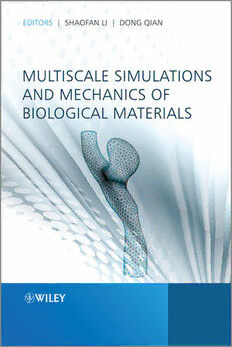
Multiscale Simulations and Mechanics of Biological Materials PDF
Preview Multiscale Simulations and Mechanics of Biological Materials
MULTISCALE SIMULATIONS AND MECHANICS OF BIOLOGICAL MATERIALS MULTISCALE SIMULATIONS AND MECHANICS OF BIOLOGICAL MATERIALS Editedby ShaofanLi UniversityofCaliforniaatBerkeley,USA DongQian UniversityofTexasatDallas,USA A John Wiley & Sons, Ltd., Publication Thiseditionfirstpublished2013 (cid:2)C 2013JohnWiley&Sons,Ltd Registeredoffice JohnWiley&SonsLtd,TheAtrium,SouthernGate,Chichester,WestSussex,PO198SQ,UnitedKingdom Fordetailsofourglobaleditorialoffices,forcustomerservicesandforinformationabouthowtoapplyfor permissiontoreusethecopyrightmaterialinthisbookpleaseseeourwebsiteatwww.wiley.com. TherightoftheauthortobeidentifiedastheauthorofthisworkhasbeenassertedinaccordancewiththeCopyright, DesignsandPatentsAct1988. Allrightsreserved.Nopartofthispublicationmaybereproduced,storedinaretrievalsystem,ortransmitted,inany formorbyanymeans,electronic,mechanical,photocopying,recordingorotherwise,exceptaspermittedbytheUK Copyright,DesignsandPatentsAct1988,withoutthepriorpermissionofthepublisher. Wileyalsopublishesitsbooksinavarietyofelectronicformats.Somecontentthatappearsinprintmaynotbe availableinelectronicbooks. Designationsusedbycompaniestodistinguishtheirproductsareoftenclaimedastrademarks.Allbrandnamesand productnamesusedinthisbookaretradenames,servicemarks,trademarksorregisteredtrademarksoftheir respectiveowners.Thepublisherisnotassociatedwithanyproductorvendormentionedinthisbook.This publicationisdesignedtoprovideaccurateandauthoritativeinformationinregardtothesubjectmattercovered.Itis soldontheunderstandingthatthepublisherisnotengagedinrenderingprofessionalservices.Ifprofessionaladvice orotherexpertassistanceisrequired,theservicesofacompetentprofessionalshouldbesought. LibraryofCongressCataloging-in-PublicationData Multiscalesimulationsandmechanicsofbiologicalmaterials/editedbyProfessorShaofanLi,DrDongQian. pagescm Includesbibliographicalreferencesandindex. ISBN978-1-118-35079-9(cloth) 1.Biomechanics. 2.Biomedicalmaterials–Mechanicalproperties. 3.Multiscalemodeling. I.Li,Shaofan, editorofcompilation. II.Qian,Dong,editorofcompilation. QH513.M852013 612.7(cid:3)6–dc23 2012040166 AcataloguerecordforthisbookisavailablefromtheBritishLibrary. ISBN:9781118350799 Typesetin9/11ptTimesbyAptaraInc.,NewDelhi,India Contents AbouttheEditors xv ListofContributors xvii Preface xxi PartI MULTISCALESIMULATIONTHEORY 1 Atomistic-to-ContinuumCouplingMethodsforHeatTransferinSolids 3 GregoryJ.Wagner 1.1 Introduction 3 1.2 TheCoupledTemperatureField 5 1.2.1 SpatialReduction 5 1.2.2 TimeAveraging 6 1.3 CouplingtheMDandContinuumEnergy 7 1.3.1 TheCoupledSystem 7 1.3.2 ContinuumHeatTransfer 8 1.3.3 AugmentedMD 8 1.4 Examples 9 1.4.1 One-DimensionalHeatConduction 9 1.4.2 ThermalResponseofaCompositeSystem 10 1.5 CoupledPhonon-ElectronHeatTransport 12 1.6 Examples:Phonon–ElectronCoupling 14 1.6.1 EquilibrationofElectron/PhononEnergies 14 1.6.2 LaserHeatingofaCarbonNanotube 15 1.7 Discussion 17 Acknowledgments 18 References 18 2 AccurateBoundaryTreatmentsforConcurrentMultiscaleSimulations 21 ShaoqiangTang 2.1 Introduction 21 2.2 TimeHistoryKernelTreatment 22 2.2.1 HarmonicChain 22 2.2.2 SquareLattice 23 vi Contents 2.3 VelocityInterfacialConditions:MatchingtheDifferentialOperator 27 2.4 MBCs:MatchingtheDispersionRelation 30 2.4.1 HarmonicChain 30 2.4.2 FCCLattice 33 2.5 AccurateBoundaryConditions:MatchingtheTimeHistoryKernelFunction 36 2.6 Two-WayBoundaryConditions 39 2.7 Conclusions 41 Acknowledgments 41 References 41 3 AMultiscaleCrystalDefectDynamicsandItsApplications 43 LishengLiuandShaofanLi 3.1 Introduction 43 3.2 MultiscaleCrystalDefectDynamics 44 3.3 HowandWhytheMCDDModelWorks 47 3.4 MultiscaleFiniteElementDiscretization 47 3.5 NumericalExamples 52 3.6 Discussion 54 Acknowledgments 54 Appendix 55 References 57 4 ApplicationofMany-RealizationMolecularDynamicsMethodtoUnderstandthe PhysicsofNonequilibriumProcessesinSolids 59 YaoFuandAlbertC.To 4.1 ChapterOverviewandBackground 59 4.2 Many-RealizationMethod 60 4.3 ApplicationoftheMany-RealizationMethodtoShockAnalysis 62 4.4 Conclusions 72 Acknowledgments 74 References 74 5 Multiscale,MultiphysicsModelingofElectromechanicalCouplingin Surface-DominatedNanostructures 77 HaroldS.ParkandMichelDevel 5.1 Introduction 77 5.2 AtomisticElectromechanicalPotentialEnergy 79 5.2.1 AtomisticElectrostaticPotentialEnergy:GaussianDipoleMethod 80 5.2.2 FiniteElementEquilibriumEquationsfromTotalElectromechanical PotentialEnergy 83 5.3 BulkElectrostaticPiola–KirchoffStress 84 5.3.1 Cauchy–BornKinematics 84 5.3.2 ComparisonofBulkElectrostaticStresswithMolecularDynamics ElectrostaticForce 86 5.4 SurfaceElectrostaticStress 87 5.5 One-DimensionalNumericalExamples 89 5.5.1 VerificationofBulkElectrostaticStress 89 5.5.2 VerificationofSurfaceElectrostaticStress 91 Contents vii 5.6 ConclusionsandFutureResearch 94 Acknowledgments 95 References 95 6 TowardsaGeneralPurposeDesignSystemforComposites 99 JacobFish 6.1 Motivation 99 6.2 GeneralPurposeMultiscaleFormulation 103 6.2.1 TheBasicReduced-OrderModel 103 6.2.2 EnhancedReduced-OrderModel 104 6.3 MechanisticModelingofFatigueviaMultipleTemporalScales 106 6.4 CouplingofMechanicalandEnvironmentalDegradationProcesses 107 6.4.1 MathematicalModel 107 6.4.2 MathematicalUpscaling 109 6.4.3 ComputationalUpscaling 110 6.5 UncertaintyQuantificationofNonlinearModelofMicro-Interfacesand Micro-Phases 111 References 113 PartII PATIENT-SPECIFICFLUID-STRUCTUREINTERACTIONMODELING, SIMULATIONANDDIAGNOSIS 7 Patient-SpecificComputationalFluidMechanicsofCerebralArterieswith AneurysmandStent 119 KenjiTakizawa,KathleenSchjodt,AnthonyPuntel,NikolayKostov, andTayfunE.Tezduyar 7.1 Introduction 119 7.2 MeshGeneration 120 7.3 ComputationalResults 124 7.3.1 ComputationalModels 124 7.3.2 ComparativeStudy 131 7.3.3 EvaluationofZero-ThicknessRepresentation 142 7.4 ConcludingRemarks 145 Acknowledgments 146 References 146 8 ApplicationofIsogeometricAnalysistoSimulateLocalNanoparticulateDrug DeliveryinPatient-SpecificCoronaryArteries 149 ShaolieS.HossainandYongjieZhang 8.1 Introduction 149 8.2 MaterialsandMethods 151 8.2.1 MathematicalModeling 151 8.2.2 ParameterSelection 156 8.2.3 MeshGenerationfromMedicalImagingData 158 8.3 Results 159 8.3.1 ExtractionofNPWallDepositionData 159 8.3.2 DrugDistributioninaNormalArteryWall 160 8.3.3 DrugDistributioninaDiseasedArteryWallwithaVulnerablePlaque 160 viii Contents 8.4 ConclusionsandFutureWork 165 Acknowledgments 166 References 166 9 ModelingandRapidSimulationofHigh-FrequencyScatteringResponses ofCellularGroups 169 TarekIsmailZohdi 9.1 Introduction 169 9.2 RayTheory:ScopeofUseandGeneralRemarks 171 9.3 RayTheory 173 9.4 PlaneHarmonicElectromagneticWaves 177 9.4.1 GeneralPlaneWaves 177 9.4.2 ElectromagneticWaves 177 9.4.3 OpticalEnergyPropagation 178 9.4.4 ReflectionandAbsorptionofEnergy 179 9.4.5 ComputationalAlgorithm 183 9.4.6 ThermalConversionofOpticalLosses 187 9.5 Summary 190 References 190 10 ElectrohydrodynamicAssemblyofNanoparticlesfor NanoengineeredBiosensors 193 Jae-HyunChung,Hyun-BooLee,andJong-HoonKim 10.1 IntroductionforNanoengineeredBiosensors 193 10.2 Electric-Field-InducedPhenomena 193 10.2.1 Electrophoresis 194 10.2.2 Dielectrophoresis 195 10.2.3 ElectroosmoticandElectrothermalFlow 198 10.2.4 BrownianMotionForcesandDragForces 199 10.3 GeometryDependencyofDielectrophoresis 200 10.4 Electric-Field-GuidedAssemblyofFlexibleMoleculesinCombinationwith otherMechanisms 203 10.4.1 DielectrophoresisinCombinationwithFluidFlow 203 10.4.2 DielectrophoresisinCombinationwithBindingAffinity 203 10.4.3 DielectrophoresisinCombinationwithCapillaryActionandViscosity 203 10.5 SelectiveAssemblyofNanoparticles 204 10.5.1 Size-SelectiveDepositionofNanoparticles 204 10.5.2 Electric-PropertySortingofNanoparticles 205 10.6 SummaryandApplications 205 References 205 11 AdvancementsintheImmersedFinite-ElementMethodandBio-Medical Applications 207 LucyZhang,XingshiWang,andChuWang 11.1 Introduction 207 11.2 Formulation 208 11.2.1 TheImmersedFiniteElementMethod 208 11.2.2 Semi-ImplicitImmersedFiniteElementMethod 210 Contents ix 11.3 Bio-MedicalApplications 211 11.3.1 RedBloodCellinBifurcatedVessels 211 11.3.2 HumanVocalFoldsVibrationduringPhonation 214 11.4 Conclusions 217 References 217 12 ImmersedMethodsforCompressibleFluid–SolidInteractions 219 XiaodongSheldonWang 12.1 BackgroundandObjectives 219 12.2 ResultsandChallenges 222 12.2.1 Formulations,Theories,andResults 222 12.2.2 StabilityAnalysis 227 12.2.3 KernelFunctions 228 12.2.4 ASimpleModelProblem 231 12.2.5 CompressibleFluidModelforGeneralGrids 231 12.2.6 MultigridPreconditioner 232 12.3 Conclusion 234 References 234 PartIII FROMCELLULARSTRUCTURETOTISSUESANDORGANS 13 TheRoleoftheCorticalMembraneinCellMechanics:ModelandSimulation 241 LouisFoucard,XavierEspinet,EduardBenet,andFranckJ.Vernerey 13.1 Introduction 241 13.2 ThePhysicsoftheMembrane–CortexComplexandItsInteractions 243 13.2.1 TheMechanicsoftheMembrane–CortexComplex 243 13.2.2 InteractionoftheMembranewiththeOuterEnvironment 247 13.3 FormulationoftheMembraneMechanicsandFluid–MembraneInteraction 249 13.3.1 KinematicsofImmersedMembrane 249 13.3.2 VariationalFormulationoftheImmersedMCCProblem 251 13.3.3 PrincipleofVirtualPowerandConservationofMomentum 253 13.4 TheExtendedFiniteElementandtheGrid-BasedParticleMethods 255 13.5 Examples 257 13.5.1 TheEquilibriumShapesoftheRedBloodCell 257 13.5.2 CellEndocytosis 259 13.5.3 CellBlebbing 260 13.6 Conclusion 262 Acknowledgments 263 References 263 14 RoleofElastininArterialMechanics 267 YanhangZhangandShahrokhZeinali-Davarani 14.1 Introduction 267 14.2 TheRoleofElastininVascularDiseases 268 14.3 MechanicalBehaviorofElastin 269 14.3.1 OrthotropicHyperelasticityinArterialElastin 269 14.3.2 ViscoelasticBehavior 271 x Contents 14.4 ConstitutiveModelingofElastin 272 14.5 Conclusions 276 Acknowledgments 276 References 277 15 CharacterizationofMechanicalPropertiesofBiologicalTissue:Applicationto theFEMAnalysisoftheUrinaryBladder 283 EugenioOn˜ate,FacundoJ.Bellomo,VirginiaMonteiro,SergioOller,andLizG.Nallim 15.1 Introduction 283 15.2 InverseApproachfortheMaterialCharacterizationofBiologicalSoftTissuesviaa GeneralizedRuleofMixtures 284 15.2.1 ConstitutiveModelforMaterialCharacterization 284 15.2.2 DefinitionoftheObjectiveFunctionandMaterialsCharacterization Procedure 286 15.2.3 ValidationoftheInverseModelforUrinaryBladderTissue Characterization 287 15.3 FEMAnalysisoftheUrinaryBladder 289 15.3.1 ConstitutiveModelforTissueAnalysis 290 15.3.2 Validation.TestInflationofaQuasi-incompressibleRubberSphere 292 15.3.3 MechanicalSimulationofHumanUrinaryBladder 293 15.3.4 StudyofUrine–BladderInteraction 295 15.4 Conclusions 298 Acknowledgments 298 References 298 16 StructureDesignofVascularStents 301 YalingLiu,JieYang,YihuaZhou,andJiaHu 16.1 Introduction 301 16.2 IdealVascularStents 303 16.3 DesignParametersthatAffectthePropertiesofStents 304 16.3.1 ExpansionMethod 305 16.3.2 StentMaterials 305 16.3.3 StructureofStents 306 16.3.4 EffectofDesignParametersonStentProperties 308 16.4 MainMethodsforVascularStentDesign 308 16.5 VascularStentDesignMethodPerspective 316 References 316 17 ApplicationsofMeshfreeMethodsinExplicitFractureandMedicalModeling 319 DanielC.Simkins,Jr. 17.1 Introduction 319 17.2 ExplicitCrackRepresentation 319 17.2.1 Two-DimensionalCracks 320 17.2.2 Three-DimensionalCracksinThinShells 323 17.2.3 MaterialModelRequirements 323 17.2.4 CrackExamples 323 17.3 MeshfreeModelinginMedicine 327 Acknowledgments 331 References 331 Contents xi 18 DesignofDynamicandFatigue-Strength-EnhancedOrthopedicImplants 333 SagarBhamare,SeethaRamaiahMannava,LeonoraFelon,DavidKirschman, VijayVasudevan,andDongQian 18.1 Introduction 333 18.2 FatigueLifeAnalysisofOrthopedicImplants 335 18.2.1 FatigueLifeTestingforImplants 335 18.2.2 FatigueLifePrediction 337 18.3 LSPProcess 338 18.4 LSPModelingandSimulation 339 18.4.1 PressurePulseModel 339 18.4.2 ConstitutiveModel 340 18.4.3 SolutionProcedure 341 18.5 ApplicationExample 342 18.5.1 ImplantRodDesign 342 18.5.2 ResidualStresses 342 18.5.3 FatigueTestsandLifePredictions 344 18.6 Summary 348 Acknowledgments 348 References 349 PartIV BIO-MECHANICSANDMATERIALSOFBONESANDCOLLAGENS 19 ArchetypeBlendingContinuumTheoryandCompactBoneMechanics 353 KhalilI.Elkhodary,MichaelStevenGreene,andDevinO’Connor 19.1 Introduction 353 19.1.1 AShortLookattheHierarchicalStructureofBone 354 19.1.2 ABackgroundofGeneralizedContinuumMechanics 355 19.1.3 NotesontheArchetypeBlendingContinuumTheory 356 19.2 ABCFormulation 358 19.2.1 PhysicalPostulatesandtheResultingKinematics 358 19.2.2 ABCVariationalFormulation 359 19.3 ConstitutiveModelinginABC 361 19.3.1 GeneralConcept 361 19.3.2 BlendingLawsforCorticalBoneModeling 363 19.4 TheABCComputationalModel 367 19.5 ResultsandDiscussion 368 19.5.1 PropagatingStrainInhomogeneitiesacrossOsteons 368 19.5.2 NormalandShearStressesinOsteons 369 19.5.3 RotationandDisplacementFieldsinOsteons 370 19.5.4 DampinginCementLines 372 19.5.5 QualitativeLookatStrainGradientsinOsteons 372 19.6 Conclusion 373 Acknowledgments 374 References 374 20 Image-BasedMultiscaleModelingofPorousBoneMaterials 377 JudyP.Yang,Sheng-WeiChi,andJiun-ShyanChen 20.1 Overview 377 20.2 HomogenizationofPorousMicrostructures 379
